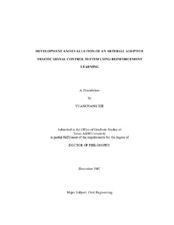| dc.contributor.advisor | Zhang, Yunlong | |
| dc.creator | Xie, Yuanchang | |
| dc.date.accessioned | 2010-01-15T00:05:34Z | |
| dc.date.accessioned | 2010-01-16T00:35:51Z | |
| dc.date.available | 2010-01-15T00:05:34Z | |
| dc.date.available | 2010-01-16T00:35:51Z | |
| dc.date.created | 2007-12 | |
| dc.date.issued | 2009-05-15 | |
| dc.identifier.uri | https://hdl.handle.net/1969.1/ETD-TAMU-2480 | |
| dc.description.abstract | This dissertation develops and evaluates a new adaptive traffic signal control
system for arterials. This control system is based on reinforcement learning, which is an
important research area in distributed artificial intelligence and has been extensively
used in many applications including real-time control.
In this dissertation, a systematic comparison between the reinforcement learning
control methods and existing adaptive traffic control methods is first presented from the
theoretical perspective. This comparison shows both the connections between them and
the benefits of using reinforcement learning. A Neural-Fuzzy Actor-Critic
Reinforcement Learning (NFACRL) method is then introduced for traffic signal control.
NFACRL integrates fuzzy logic and neural networks into reinforcement learning and can
better handle the curse of dimensionality and generalization problems associated with
ordinary reinforcement learning methods.
This NFACRL method is first applied to isolated intersection control. Two
different implementation schemes are considered. The first scheme uses a fixed phase sequence and variable cycle length, while the second one optimizes phase sequence in
real time and is not constrained to the concept of cycle. Both schemes are further
extended for arterial control, with each intersection being controlled by one NFACRL
controller. Different strategies used for coordinating reinforcement learning controllers
are reviewed, and a simple but robust method is adopted for coordinating traffic signals
along the arterial.
The proposed NFACRL control system is tested at both isolated intersection and
arterial levels based on VISSIM simulation. The testing is conducted under different
traffic volume scenarios using real-world traffic data collected during morning, noon,
and afternoon peak periods. The performance of the NFACRL control system is
compared with that of the optimized pre-timed and actuated control.
Testing results based on VISSIM simulation show that the proposed NFACRL
control has very promising performance. It outperforms optimized pre-timed and
actuated control in most cases for both isolated intersection and arterial control. At the
end of this dissertation, issues on how to further improve the NFACRL method and
implement it in real world are discussed. | en |
| dc.format.medium | electronic | en |
| dc.format.mimetype | application/pdf | |
| dc.language.iso | en_US | |
| dc.subject | Reinforcement Learning | en |
| dc.subject | Adaptive Traffic Signal Control | en |
| dc.subject | Arterial | en |
| dc.subject | Dynamic Programming | en |
| dc.subject | Agent | en |
| dc.title | Development and evaluation of an arterial adaptive traffic signal control system using reinforcement learning | en |
| dc.type | Book | en |
| dc.type | Thesis | en |
| thesis.degree.department | Civil Engineering | en |
| thesis.degree.discipline | Civil Engineering | en |
| thesis.degree.grantor | Texas A&M University | en |
| thesis.degree.name | Doctor of Philosophy | en |
| thesis.degree.level | Doctoral | en |
| dc.contributor.committeeMember | Butenko, Sergiy | |
| dc.contributor.committeeMember | Lord, Dominique | |
| dc.contributor.committeeMember | Quadrifoglio, Luca | |
| dc.type.genre | Electronic Dissertation | en |
| dc.type.material | text | en |
| dc.format.digitalOrigin | born digital | en |


